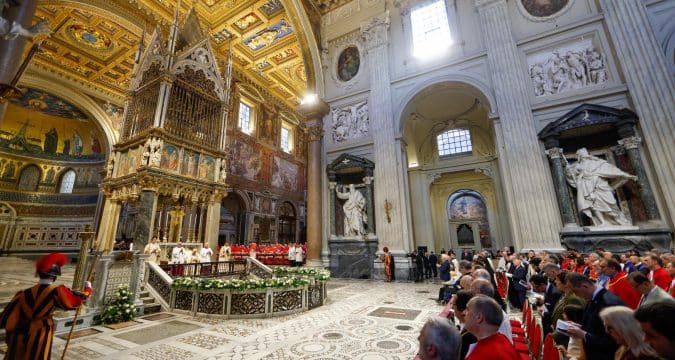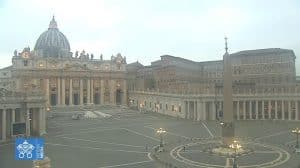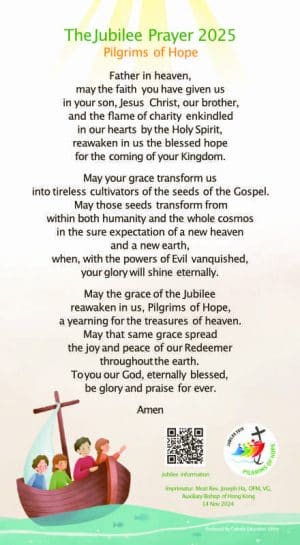
(OSV News): Situated on the outskirts of ancient Rome along the still-visible Aurelian Walls is the Archbasilica of St. John Lateran, the cathedral of Rome. The site of the pope’s residence for nearly 1,000 years, five of the Church’s ecumenical councils, and the signing of a pivotal 1929 treaty between Italy and the Holy See, St. John Lateran is celebrated by the whole Church annually with the feast of its dedication on November 9.
This year marks its 1,700th anniversary. The dedication’s feast day is a required liturgical celebration on the Roman liturgical calendar, setting it apart from optional feasts commemorating Rome’s three other major basilicas—the Dedication of the Basilica of St. Mary Major on August 5, and the Dedication of the Basilicas of Ss. Peter and Paul, Apostles [St. Peter’s Basilica and the Basilica of St. Paul Outside the Walls] on November 18.
For the same reason St. John Lateran’s facade bears the Latin inscription of “Mother and Head of all the Churches in the City and the World,” explained Father John Wauck, who teaches literature and communication of the faith at the Pontifical University of the Holy Cross in Rome. As the cathedral of the Diocese of Rome, it—not St. Peter’s Basilica—is the church of the bishop of Rome, the pope. And as the mother hurch of Rome, it is united to all other churches in the world.
Father Wauck explained that the anniversary of the dedication of the cathedral of each diocese is observed as a feast day, so with St. John Lateran, that observance is extended to the universal Church.
As the cathedral of the Diocese of Rome, it—not St. Peter’s Basilica—is the church of the bishop of Rome, the pope. And as the mother hurch of Rome, it is united to all other churches in the world
The importance the Church places in its sacred buildings connects to Jesus’ ministry, he said. “What he came to do was a construction project. He tells Peter, ‘On you, on this rock, I’m going to build my Church’ … He doesn’t say, ‘I’m going to write a book.’ He doesn’t leave any books. He leaves followers to form what he calls a Church, and he says he’s going to build it. … The physical church is like the incarnation of the spiritual thing that is a church.”
Dedicated to Christ the Savior in 324, St. John Lateran was later placed under the additional patronage of St. John the Baptist and St. John the Evangelist, with the formal name of the Papal Archbasilica of the Most Holy Saviour and Ss. John the Baptist and John the Evangelist at the Lateran.

Pope Francis and Angelo Cardinal De Donatis, papal vicar of Rome, sit in front of the main altar in Rome’s Basilica of St. John Lateran during a meeting with priests and deacons working in the Diocese of Rome on January 13. Photo: CNS/Vatican Media
“Lateran” refers to its location on a hill that was formerly the Roman estate of the Laterani family. It is also the only Catholic church styled as an “archbasilica.”
St. John Lateran’s 1,700th anniversary is more than a milestone for a particular church, art historian, Elizabeth Lev, explained. As the first legally-built public church in the world, it marks the legalisation of Christianity and the advent of public Christian worship, she said.
Dedicated to Christ the Savior in 324, St. John Lateran was later placed under the additional patronage of St. John the Baptist and St. John the Evangelist
“It establishes the moment that Christianity can make its presence publicly felt in the city,” said Lev, a college instructor and sought-after Roman tour guide.
The Roman emperor, Constantine the Great, legalised Christianity with the Edict of Milan in 313 after he claimed a vision from God on the eve of the pivotal Battle of the Milv Twelve Apostles added ahead of the basilica’s reconstruction f Jubilee Year in 2025 declared by Pope Francis.
St. John Lateran includes one of the oldest extant baptisteries in Christendom, ornate spiraling columns in its medieval cloister, and a glittering mosaic of Christ and saints in its apse.
The basilica is also home to important relics such as the skulls of Ss. Peter and Paul, part of the table of the Last Supper, and, outside in its own chapel, the Scala Sancta, or the holy steps said to be the ones Jesus climbed to Pontius Pilate in Rome, brought to Rome by Constantine’s devout Christian mother, St. Helena.
The central, papal altar contains the remnants of an old wooden table that is said to have served as St. Peter’s altar when he was bishop of Rome, which, Lev said, “is a reminder that when Peter was here running the Church, as it were, he was always looking over his shoulder.”
It’s the first church, and it’s been changed and added to, and you see all of these different layers
Duncan Stroik
She observed, “This was an illegal religion that was being hunted down by Romans … so Peter really isn’t really established anywhere, he’s just going from place to place. When they built this church that wooden altar could come to rest inside a stone altar, because it’s not going anywhere.”
While construction on St. Peter’s fourth-century basilica—known as Old Lev said that St. John Lateran’s evolution over the centuries is evident with architectural and art styles of every period. However, after countless renovations, very little of the original building is visible.
“It’s the first church, and it’s been changed and added to, and you see all of these different layers,” Duncan Stroik, a practicing architect who teaches at the University of Notre Dame School of Architecture said.
“You see a cosmatesque floor, you see the Renaissance ceiling, you see the beautiful transept done in the Holy Year of 1600 that’s focused on the Eucharist, you have the apse with the throne of the bishop” in a medieval revival style from the 19th century, “and a baroque nave.”
However, St. John Lateran is far less visited than St. Peter’s Basilica in Vatican City, which Pope Francis recently said draws 40,000 visitors each day. By contrast, a person can easily enter St. John Lateran without lines and “you have the place to yourself,” Stroik said.
If in Rome the architectural glory of St. Peter’s Basilica is the Catholic Church’s “game face,” making the Catholic Church’s long history “look easy,” then St. John Lateran reveals the flip side, Lev said.
“St. John Lateran reminds us that 2,000 years is not that easy,” Lev said, noting that the church has endured earthquakes, fires and sacking by invaders. “It really had to be reconstructed over and over and over again,” she said, adding that that history makes it a symbol of the Church itself.








